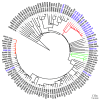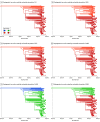Analysis of Genomic Characteristics and Transmission Routes of Patients With Confirmed SARS-CoV-2 in Southern California During the Early Stage of the US COVID-19 Pandemic
- PMID: 33026453
- PMCID: PMC7542329
- DOI: 10.1001/jamanetworkopen.2020.24191
Analysis of Genomic Characteristics and Transmission Routes of Patients With Confirmed SARS-CoV-2 in Southern California During the Early Stage of the US COVID-19 Pandemic
Abstract
Importance: In late December 2019, an outbreak of a novel severe acute respiratory syndrome coronavirus 2 (SARS-CoV-2) emerged in Wuhan, China. Data on the routes of transmission to Los Angeles, California, the US West Coast epicenter for coronavirus disease 2019 (COVID-19), and subsequent community spread are limited.
Objective: To determine the transmission routes of SARS-CoV-2 to Southern California and elucidate local community spread within the Los Angeles metropolitan area.
Design, setting, and participants: This case series included 192 consecutive patients with reverse transcription-polymerase chain reaction (RT-PCR) test results positive for SARS-CoV-2 who were evaluated at Cedars-Sinai Medical Center in Los Angeles, California, from March 22 to April 15, 2020. Data analysis was performed from April to May 2020.
Main outcomes and measures: SARS-CoV-2 viral genomes were sequenced. Los Angeles isolates were compared with genomes from global subsampling and from New York, New York; Washington state; and China to determine potential sources of viral dissemination. Demographic data and outcomes were collected.
Results: The cohort included 192 patients (median [interquartile range] age, 59.5 [43-75] years; 110 [57.3%] men). The genetic characterization of SARS-CoV-2 isolates in the Los Angeles population pinpointed community transmission of 13 patients within a 3.81 km2 radius. Variation landscapes of this case series also revealed a cluster of 10 patients that contained 5 residents at a skilled nursing facility, 1 resident of a nearby skilled nursing facility, 3 health care workers, and a family member of a resident of one of the skilled nursing facilities. Person-to-person transmission was detected in a cluster of 5 patients who shared the same single-nucleotide variation in their SARS-CoV-2 genomes. High viral genomic diversity was identified: 20 Los Angeles isolates (15.0%) resembled SARS-CoV-2 genomes from Asia, while 109 Los Angeles isolates (82.0%) were similar to isolates originating from Europe. Analysis of other common respiratory viral pathogens did not reveal coinfection in the cohort.
Conclusions and relevance: These findings highlight the precision of detecting person-to-person transmission and accurate contact tracing directly through SARS-CoV-2 genome isolation and sequencing. Development and application of phylogenetic analyses from the Los Angeles population established connections between COVID-19 clusters locally and throughout the US.
Conflict of interest statement
Figures




References
-
- Kucharski AJ, Russell TW, Diamond C, et al. ; Centre for Mathematical Modelling of Infectious Diseases COVID-19 working group . Early dynamics of transmission and control of COVID-19: a mathematical modelling study. Lancet Infect Dis. 2020;20(5):553-558. doi: 10.1016/S1473-3099(20)30144-4 - DOI - PMC - PubMed
Publication types
MeSH terms
Substances
LinkOut - more resources
Full Text Sources
Miscellaneous

